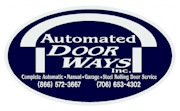A MULTI-POINT SAFETY CHECKLIST FOR AUTOMATED SLIDING DOORS
Safe uses of automated sliding doors should never be a passing thought. Making sure yours are functioning properly and not putting users at risk of injury needs to be high on your priority list.
Fortunately, keeping your automatic sliding door users safe is simple with our daily safety checklist that addresses:
- Activation
- Door hardware
- Area surrounding the door
1. Activation
Ensuring safe activation and operation involves testing sensors, mats, holding beams, and closing speed.
Here’s what we suggest for each:
- Sensors
Walk to the door at a normal pace. When you’re about four feet from the door, it should start opening. The door should slide open smoothly, and it should stop without impact. The sensor pattern should provide effective detection within 5″ (or less) from the face of the door (measured from the center of the clear opening) and extend outward to a minimum of 43″ from the face of the door. This zone should be at least equal to the clear opening width of the door when measured at 8″ and 30″, extending perpendicular from the door face. The sensor should be able to detect objects with a minimum height of 28″. When you step out of the sensor pattern, the door should not start to close before 1.5 seconds have passed.
- Mats
Step on the opening mat. The door should swing open smoothly and stop without impact. A mat should be no less wide than the door opening minus 5” on each side. Walk-test each side if there are mats on each side. At the threshold, no more than 6″ of inactive area should exist. After you step off the mat, the door should start to close only after at least 1.5 seconds have passed. To detect any inappropriate dead spots on the mats, walk-test them by standing at several locations.
- Safety Beams
While not always required on automatic sliding doors photoelectric beams offer protection in the threshold area of a sliding door. If the beam is broken, the door should stop until the connection is restored. To test a safety beam, remain still on the door threshold (i.e., directly between the doors or between the door and jamb on a single leaf slider). When you do so, the door should remain open. Cover the doorway holding beam with your hand and remain still. If closed at the time, the door should open fully. If the door is open when covering the doorway holding beam, it should remain open for at least 1.5 seconds after you move your hand. If other safety devices are also being used, crouch motionless in the door opening for 10 seconds. The door should not close. The lower holding beam or sensors should detect objects 28” tall.
- Closing Speed
Your automatic sliding door should not close faster than 1 foot per second. When a door is no less than 2″ from its fully closed position, its closing speed should become noticeably slower.
2. Door Hardware
Don’t ignore the integrity and condition of the door hardware when assessing the safety of an automatic sliding door.
- Inspect the mat molding and threshold to make sure they’re complete and secured with all screws tightened.
- Check the door panels for broken or cracked glass.
- Make sure every automatic sliding door has an Emergency Push Open sign and a Caution Automatic Door sign on it. Each of these signs should be 58″ (give or take 5″) from the floor.
3. Area Around The Door
Not only are proper function and parts of a door critical to safety, but also is what’s happening around it.
- Make sure no bulletin boards, brochure racks, marketing displays, or other distractions stand in the door area and put people at risk of getting hit by the door when perusing the literature.
- Keep the floor guides clean and free of debris that could prevent the door from sliding correctly.
- Make sure all door covers are properly secured.
- Check the door area for tripping or slipping hazards.
